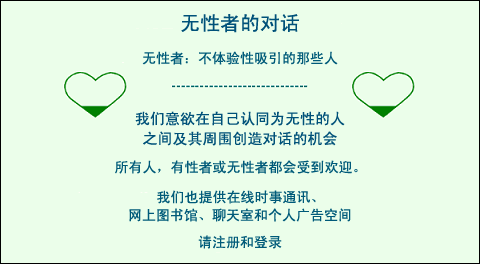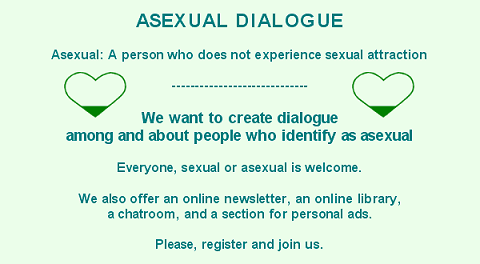|
最近数年来,另一种族群组织也已经设法作为性少数而组织起来,这个族群就是“无性者(asexual)”。
从生物学上看,“无性的(asexual)”这个词语的意思是“无性征的、缺乏性兴趣的、无性行为的(sexless)”,即指没有性器官或无性活动的意思。例如,传统的典型用法是这样表达的——“无性生殖(asexual
reproduction)”(无性生殖在微生物中是普遍存在的,除此以外,在一些植物中、甚至在少数动物中也存在)。
不过,在这个新兴权利运动中活跃的个人是一些在生理上健康的人,他们用一个新的定义来界定自己,即:无性者是指对任何类型的性行为没有任何兴趣的人,也指对他人没有性吸引力的人。一些激进人士由于拒绝被人贴上性紊乱(sexual
disorder)的标签,他们宣称无性就是一种性取向或者就是一种单独的性别认同[1],不过,这遭到了其他人的阻拦或反对。不管怎样,许多无性者感到自己被忽视了,被误解了,而且在一定程度上感到自己受到了压制,因为他们周围的社会并没有把他们当一回事儿。无性者设法通过数量上取得优势的方法,希望逃避要适应社会环境的压力。这种潜在的性少数族群的规模究竟有多大,终归是所有人想要猜出来的谜底。一项研究估计大约占人口的1%,不过在这样的数据被证实之前,尚要做更深入的探讨[2]。
不管怎样,像人类许多其它的性现象一样,无性只是一个程度的问题。一些把自己描述成无性的人毕竟可能有一定程度的性兴趣。照现在这个程度的理解看,这个术语涵盖了差异非常大的各种现象,从性厌恶、性欲缺乏或性欲低下到性欲压抑、性偏好或完全的性压抑,不一而足。一些人也许只是在性生理方面发育迟缓。甚至,年龄也可能成为自称为无性者的一个重要的因素。单凭这个原因来看,要获得无性者的精确人数也是一件困难的事情。出于同样的原因,有人可能会怀疑作为性少数的无性者的组织最终是否会获得成功。

无性者组织的典型的网站
上图是合并了的两个不同的无性者组织的网站首页。(为了避免被轻易识破,广告中这些场所的名称及其它细节内容已经有所改变,但是其活动的内容则确定无疑。)
|
|
In recent years, still another group has been trying to organize as a sexual minority - the “asexuals”.
In biology, the word “asexual” means “sexless”, i.e. it refers to the absence of sex organs or sexual activity. A typical traditional use, for example, is the expression “asexual reproduction” (it is common in micro-organisms, but occurs also in some plants and even in a few animals).
However, the individuals active in this new movement are physically healthy human beings who apply a new definition to themselves:
Asexuals are individuals who have no interest in sexual intercourse of any kind and do not feel sexually attracted to others. Rejecting the label of a sexual disorder, certain activists claim that asexuality is a distinct sexual orientation or a separate gender identity, but this is disputed by others. In any case, many asexuals feel ignored, misunderstood, and, to a certain degree, even
oppressed, since the world around them does not take them seriously. By trying to find strength in numbers, they hope to escape the pressure to conform. How large such a potential minority might turn out to be is anybody’s guess. One study has estimated ca. 1% of the population, but it will take much more research before such a figure can be confirmed
1.
In any case, asexuality is, like much else in human sexuality, a matter of degree. Some self-described asexuals may have some limited sexual interests after all. As it is now, the term covers very different things, from sexual aversion and absent or low sexual desire to inhibition and partial or complete repression. Some individuals may simply be delayed in their physical development. Indeed, age may be an important factor. For this reason alone it is difficult to arrive at precise figures. By the same token, one may doubt that the organization of asexuals as a minority will be successful in the long run.

Typical web site of an asexual organization
The above is a blend of two different asexual home pages.
(In order to avoid easy identification, the name, the overall design and various details have been changed or omitted, but the content as such is authentic.)
1. Bogaert, Anthony F. (August 2004). "Asexuality: prevalence and associated factors in a national probability sample". Journal of Sex Research 41 (3): 279-81.
|